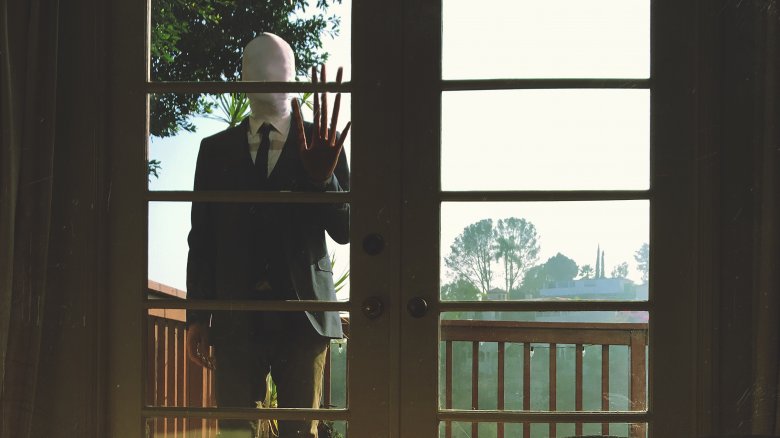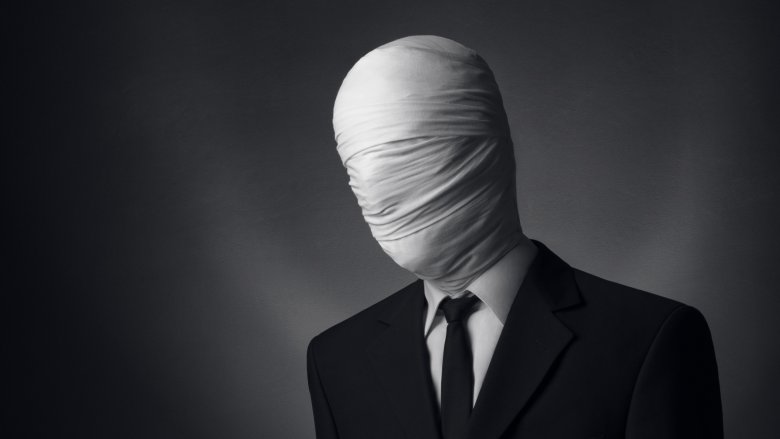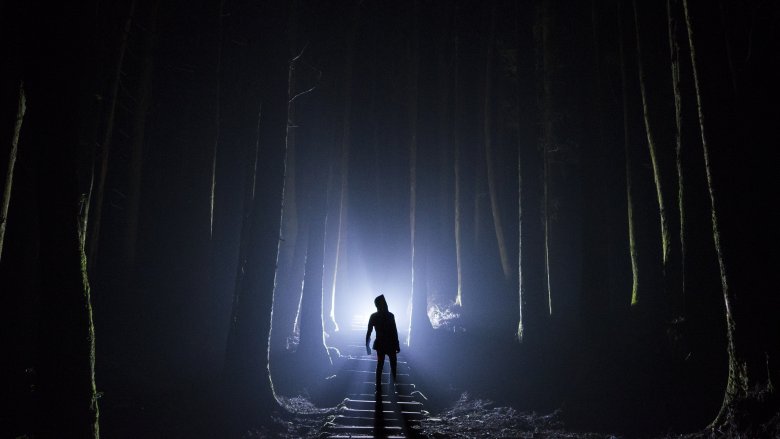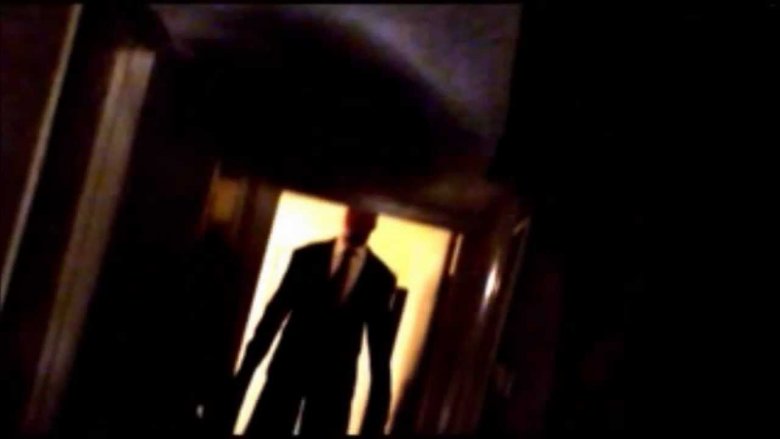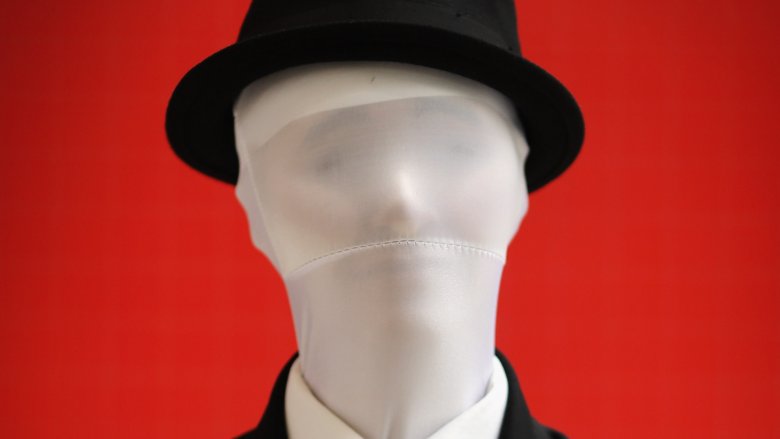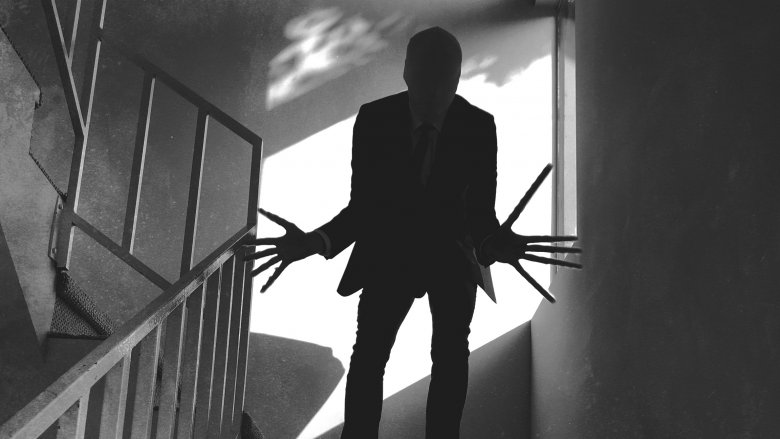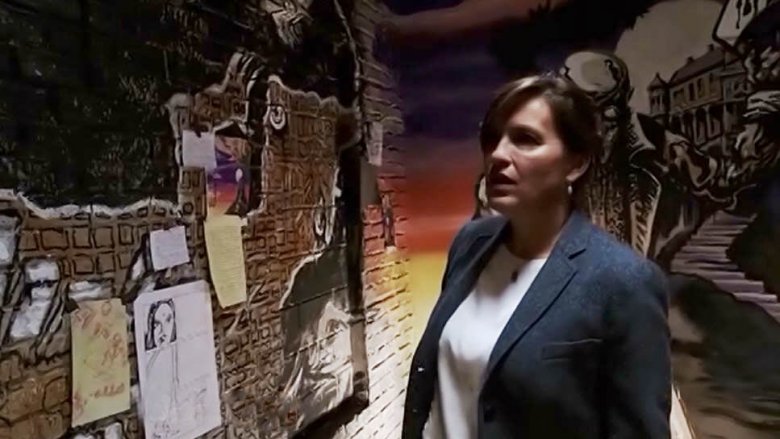The Untold Truth Of The Slender Man
The Slender Man is the undisputed horror icon of the internet age, having made his debut in 2009 in a forum thread about paranormal images on the Something Awful forums. Created in a pair of captioned images by forum user Victor Surge (whose real name is Erik Knudsen), the character took off like wildfire within the thread and soon inspired legions of fan art, stories, blog posts, and perhaps most significantly, YouTube-based series, vlogs, and alternate reality games (ARGs). Soon, anyone who spent enough time on the internet would find themselves haunted by the faceless specter, and he found a particularly enthusiastic audience among older children and teens. Uh, for better or for worse.
The release of the 2018 theatrical Slender Man movie suddenly put the internet's most notorious monster in front of a whole new audience. These are people who maybe aren't such internet regulars that they'd know everything there is to know about the tentacled man with no face but who dresses up properly when he's going to hang bags of children's blood from tree limbs. If that's you, or even if you're already a Slenderfan, read on to learn what secrets the Slender Man has to offer.
The creepiest of all pastas
By basically any metric, the Slender Man is almost certainly the most popular example of the phenomenon known as creepypasta. But what, you might be asking if you don't live full-time on the internet, is creepypasta? As Daily Dot puts it, the term "creepypasta" is a play on the earlier term "copypasta," itself a permutation of "copy/paste," used to refer to those short chunks of text you see getting copied and pasted all over Facebook and that may or may not tell you how many likes equals one prayer. Creepypasta, then, is the spooky version of that: strange, frequently short, often anonymous, chunks of story or images meant to keep you up at night as you lie with your laptop on your chest when you should have gone to bed long ago.
Notable examples include Ted the Caver (so old it's still hosted on Angelfire), The Dionaea House, Smile.jpg, and Candle Cove, which was so popular it was adapted into the first season of Syfy's anthology horror show Channel Zero. But outstripping all these in popularity is the Slender Man, who strangely, doesn't have even a short narrative as its ur-text, but instead two Photoshopped images and a caption that soon inspired an explosion of art, videos, and games that resulted in Slendy being the most notable crowdsourced monster of the internet age. Say what you will about how spooky, cool, and fun Candle Cove is, but no one is doing Pirate Percy-inspired stabbings.
The Big Five
One of the interesting aspects of the Slender Man being a more or less crowdsourced urban legend is that his mythos grew quickly and organically across several different fan works, all inspired by the original images from the Something Awful post by Victor Surge. And perhaps most interestingly, the medium by which the mythos grew the most was not written stories as with most creepypasta, but rather various video series on YouTube.
The first (popping up in the very same forum thread as the original images) and arguably most influential of these was Marble Hornets, a long-running series about a film student who finds himself haunted by visions of a long, faceless man in a black suit. Marble Hornets ran for many installments across multiple YouTube channels and a Twitter account, incorporating ARG elements and amassing hundreds of thousands of subscribers and millions of views by fans ardently straining to spot the Slender Man hiding in the background.
The second most popular Slendy series is TribeTwelve, notable for its introduction of the concept of proxies. Rounding out the "big three" video series is EverymanHYBRID, which also introduces some other spookums into the mix. These three series, plus others such as DarkHarvest00 and MLAndersen0, have been the primary driving forces behind what people "know" about the Slender Man and how he acts and operates, and have influenced how he is depicted in other media, such as video games and indie movies.
Does whatever a slender can
Despite being developed by a whole host of disparate creative sources, a sort of consensus has gradually emerged about the Slender Man and what he can do. While these might vary greatly from source to source (sometimes due to limitations of a certain medium — for example, no-budget YouTube videos — there are certain powers and abilities ol' Slendyboy can be reliably granted.
Many of these involve moving and lurking without being seen. Notably, the major source of scares in early installments of Marble Hornets and EverymanHYBRID is slowly realizing a faceless head is staring at you from the background. As such, Slendy is thought to have a form of teleportation called "slender walking" as well as camouflage and the ability to distort his presence on film and digital media. In a more proactive vein, he has the ability to control the minds of his chosen pawns, to instill victims with a kind of "slender sickness" that can cause coughing and blackouts, and the ability to control fire, which hearkens back to the very first images, in which the Slender Man is heavily implied to be responsible for a library fire.
One of the more striking but less consistent elements is the big old mess of tentacles the Slender Man is frequently depicted as having in art, but rarely in any of the video series, presumably due to limitations on budget and effects capabilities. He might use these to walk, like a spider, or grab victims, like a snazzily dressed octopus.
Watch the throne
While the Slender Man is pretty far and away the king of creepypasta mountain, there are a number of pretenders to the scary internet man throne, some of which have crossed over into Slendy's world thanks to some enterprising content creators.
One such claimant is the Rake, apparently so called because of his long, scrapy claw hands and not because he is an untrustworthy but boyishly charming cad who wears his hat at a jaunty angle. In the original story, the Rake is a frightening but vaguely humanoid figure, described as being "a naked man, or a large hairless dog of some kind" with a "disturbing and unnatural" body position, "as if it had been hit by a car or something." He is generally encountered by people who wake up in the middle of the night and find him sitting on their beds. Sleep tight with that thought in your head.
The Rake — who, though the original source of the story is unknown, seems to predate the Slender Man — got dragged into the Slender Man mythos via EverymanHYBRID. There, it makes a number of appearances and the original creepypasta is heavily referenced using the names of several characters. However, despite its popularity among creepypasta fans and its prominent place in EMH, the Rake has a long, steep climb to claw its way up if it wants to topple the Slender Man from pride of place as king of the hill.
Japan did it first
While the Slender Man has certainly inspired no shortage of imitators as creepypasta creators try to strike on the next big terrifying idea that will latch on to unsuspecting brains with its nightmare claws, in the case of the Japanese creature known as the kunekune, Slendy was beaten to the punch in almost every conceivable way: in his look, in his MO, and in his internet-based origin.
The kunekune began appearing in 2003 in stories on the internet in what basically amounted to creepypasta threads much like the one Slender Man would appear in six years later. (One of the nice things about the kunekune is that it is the rare Japanese urban legend not set in a girls' bathroom.) The kunekune is a scarecrow-like being who appears out in rice fields as a long, slender figure with a white head and wispy tendrils twisting (the name "kunekune" comes from the Japanese word for "twist") in the wind, even if the wind isn't blowing. According to stories, those who look at the kunekune too long go insane, and those who foolishly venture to touch it will die on the spot.
Apparently the only proven strategy for surviving the kunekune is to ignore it, in which case it will thankfully ignore you in return, like the opposite of a Boo from a Mario game. So, you know, if you happen to pass by a Japanese rice field and see a looming death scarecrow, just do your best not to think about how you're going to die.
Hello, Operator?
While Marble Hornets is pretty indisputably the most popular and influential YouTube-based series and ARG within the Slender Man mythos, an important fact to remember is that technically the Slender Man isn't actually in it. Sure, yes, there is a terrifying long, tall, no-face monster in a business suit who pops up in the background and does all the terrifying things we're talking about here. But that guy's name is the Operator, not Slender Man.
Does this sound like splitting hairs? Sure, perhaps. But while the creators of Marble Hornets were directly inspired by the original Something Awful posts by Victor Surge to create their video series, they soon wanted to be clear that they were blazing their own trail, and one way of doing that was by renaming their signature monster. The differences between the Operator and the OG Slender Man are stark enough that there has arisen a schism dividing Slenderfans into three main camps: Surgists, who cleave to the earliest days of the mythos; Argists, who accept material from the ARG series but reject the video games; and Contemporaries, who just eat it all up like Hungry Hungry Hippos.
The Operator, for example, is never shown to have Slender Man's trademark tentacles, and he seems to primarily draw his power from the mental influence he holds over his victims. In terms of MO, he has little in common with the child-mutilating killer of the original mythos.
The Shape of Slender
Thanks to his long and lanky frame, actor Doug Jones is a favorite casting choice for roles as monsters or aliens. He's a favorite, specifically, of director Guillermo del Toro, who cast him as Abe Sapien in two Hellboy movies, both the Faun and the Pale Man in Pan's Labyrinth, a creepy lady ghost in Crimson Peak, and the slightly more smashable serial-numbers-filed-off version of Abe Sapien from del Toro's Oscar-winning fish-sex masterpiece, The Shape of Water. Jones also notably played the Silver Surfer in Fantastic Four: Rise of the Silver Surfer and everyone's favorite horror meme from 2017, the Bye Bye Man, from the film, The Bye Bye Man.
Seems like a creepy boy built like a pipe cleaner who's used to stifling prosthetics would be a good choice to play ol' Slendyman, doesn't it? Well, you're not the only one who thinks so. While Jones didn't get cast in the 2018 Slender Man film, in which the nattily dressed entity is played by Javier Botet, he was cast as the Operator in the 2015 film Always Watching: A Marble Hornets Story, which, as the subtitle probably gives away, was a feature-length film set in the Marble Hornets universe without any of the original web series characters (other than the Operator, of course).
So now if someone asks you what the Slender Man and Abe Sapien have in common, you have an answer other than "Weird people on the internet want to bed them."
Slaves of the Slender Man
One of the most pervasive elements of the contemporary Slender Man mythos is that of proxies, who are basically mentally controlled slaves of the Slender Man, who do his bidding such as manipulating victims, destroying evidence, and making videos to communicate on his behalf. Proxies are especially prominent in the series TribeTwelve, which features a sizeable group of proxies known as the Collective. Of these, the most notable is the Observer, who frequently communicates with the main character of that series, and who may or may not have the ability to manipulate time and space.
Across the wide expanse of Slender Man blogs, there was a period in which proxies were a very common trope, to such an extent that some stories featured entire hordes of mindless slaves chasing after an intended victim and suddenly a bald guy in a suit didn't seem like the main threat any more. Helpfully, this blog conglomerate generated something of a hierarchy for proxies that range from the Hallowed (mindless puppets of the Slender Man) to Sleepers (people who still have their original personalities and don't remember their activities under Slendy's control) to Agents (basically cultists who worship the tall guy and may not be mind controlled at all).
The problem with the idea of proxies, of course, is that if you were a young, impressionable mind convinced that the Slender Man was real, you might want to become one, like the girls in Wisconsin who tried to sacrifice their friend to the Slender Man in 2014.
Please don't do Slender Man crimes
The incident of the 2014 Slender Man-inspired stabbing in Waukesha, Wisconsin, is well-known thanks to wide news coverage and the HBO documentary on the subject, Beware the Slenderman. Unfortunately, this was not an isolated incident.
In 2014, a woman in Cincinnati was attacked by her 13-year-old daughter brandishing a knife and wearing a white mask. The woman, who was treated for knife wounds on her face, neck, and back, says her child was obsessed with Slender Man and was trying to assume the role of the monster.
Also in 2014 — a bad year for the Slender Man – a 14-year-old girl in Port Richey, Florida, set her house on fire. Afterward, with her mother and brother having escaped unharmed, the girl told police she had been inspired to use fire to kill her family by the story of the Slender Man and the popular manga Soul Eater, which is about a death god in training who must collect human souls.
And in 2015, a rash of teen suicides on the Pine Ridge Indian Reservation was partially attributed to the influence of the Slender Man, who bears a resemblance to a traditional "suicide spirit" among a number of Native American tribes.
To any kids out there: please don't do any more crimes or suicides based on an internet ghost story.
If you or anyone you know is having suicidal thoughts, please call the National Suicide Prevention Lifeline at 1-800-273-TALK (8255).
Law and Order: Slender Victims Unit
Anything sufficiently popular is going to end up the subject of pastiche, homage, and parody, and the Slender Man is no exception. A host of references exist throughout pop culture to attest to the popularity of Slendy among today's youth.
A notable example is the Enderman, a dangerous creature in the world of Minecraft, perhaps the only thing more popular with weird kids than Slender Man himself. They are long and lanky and become dangerous when you look at them and then teleport around to attack when you turn your attention away from them.
A pony version of the Slender Man appeared in the background of the 2014 episode of My Little Pony: Friendship Is Magic called "Pinkie Apple Pie." Which ... okay.
Also in 2014, a take on Slendy called the Thinman appeared in an episode of Supernatural. It makes sense because once you're on Season 674 of a monster-hunting show, it seems like you'd readily latch on to any new monster to hit the scene before you have to resort to the boys fighting a sentient stapler or something.
Finally in 2014, a very busy year for Slendy, an episode of Law and Order: SVU told the story, ripped from the headlines, of the "Glasgowman's Wrath," in which the Slender Man was transformed into the Glasgowman (?) for some reason. You'd think an appearance on Law and Order would be enough to kill a youth culture trend, but you can't keep a Slender Man down.
